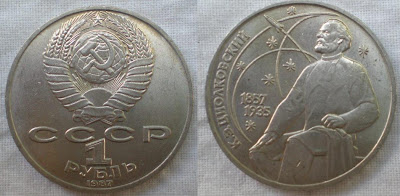1 Rouble: Constantin Tsiolkovsky
 Konstantin Tsiolkovsky was a true visionary and pioneer of astronautics. He theorized many aspects of human space travel and rocket propulsion decades before others, and played an important role in the development of the Soviet and Russian space programs.
Konstantin Tsiolkovsky was a true visionary and pioneer of astronautics. He theorized many aspects of human space travel and rocket propulsion decades before others, and played an important role in the development of the Soviet and Russian space programs.He was born on September 17,1857, in the village of Ijevskoe, Ryasan Province, Russia, the son a a Polish forester who had emigrated to Russia. He was not from a rich family, but a very large one; Konstantin Tsiolkovsky had 17 brothers and sisters. At the age of 10 he lost his hearing as the result of scarlet fever. After that he couldn't attend school, and he never recieved any formal education. The knowledge and education he attained were acheived by himself. His books were his teachers, and he read every book in his father's library. Tsiolkovsky later remembered that his hearing loss influenced greatly his future life: during all his life he tried to prove to himself and to others that he was better and more clever than others, even with his disability.
In 1873-1876 Konstantin Tsiolkovsky lived in Moscow. During this time he visited the main Moscow libraries, among them the well known Pashkov House Library. It was in this fashion that he received his self-education. While in Moscow, Tsiolkovsky was tutored by the eccentric and brilliant Russian philosopher Nikolai Fedorovitch Fedorov, who was working in a Moscow library at the time. Fedorov was a leading proponent of Russian Cosmism, and gave Tsiolkovsky a place to work in the library. In many ways, he took the place of the university lecturers that Tsiolkovsky never had access to. At the age of17, while living in Moscow, he first dreamed about the possibility of space flight. He was, in part, inspired by the novels of Jules Verne. Since that time he started to think about the problems of space vehicle design. His great purpose was not simply to go into outer space, but to live in space, for humainity to become a space civilization.
In 1876-1879, after his coming back to his father's home, he lived in Vyatka and Ryasan. After passing his exams, he recieved his Teacher's Certificate, and went to work as a math teacher in Borovsk, Kaluga Province.
In 1880-1892 Tsiolkovsky lived in Borovsk and worked as a teacher. At that time he began his scientific research in air baloon building, life in free space, aerodynamics and philosophy. It was also at that time that he married. His wife, Barbara E. Sokolova, was the daughter of the local preacher. Together, they had 3 daughters and 4 sons.
In 1892-1935 he lived and worked in Kaluga. His moving to Kaluga was the result of a teaching promotion. He lived in the house that is now a part of the museum complex with his family from the year 1904 until his death in 1935. It was here in Kaluga that he became a well known scientist, and where he wrote and published his theories of space flight and inter-planetary travels. In Kaluga he wrote his Cosmic Philosophy, and he dreamed about the far distant future of humanity, including the eventual conquest of space and our leaving the cradle of the planet Earth for the stars. He was made a member of the Soviet Academy of Science in 1919.
He received a government pension in 1920, and continued to work and write about space. Upon the publication of the works of German rocket pioneer Herman Oberth in 1923, his works were revised and published more widely, and he finally earned some international recognition for his ideas. He wrote over 500 scientific papers, and, even though he never created any rockets himself, he influenced many young Russian engineers and designers. Tsiolkovsky lived to see a younger generation of Russian engineers and scientists begin to make his visionary concepts reality. Among these was Sergey Korolev, who would become the "Chief Designer" of the Soviet space program, who launched humanity into space with Sputnik, Laika, and the launch of the first cosmonaut,Yuri Gagarin.
Konstantin E. Tsiolkovsky, the father of cosmonautics, died in Kaluga at the age of 78 on September 19,1935. He received an honored State funeral from the Soviet government. He was buried in the old Kaluga Cemetery, not far from the Museum that honors his life and work.
The tomb of Tsiolkovsky in the Old Kaluga Cemetery, near the Museum.
1 Rouble: V.I.Lenin's centenary
 Reverse: Odin Rouble, or one rouble
Reverse: Odin Rouble, or one roubleCircumscribing lettering: 100 years of birth of Lenin
Obverse: Vladimir Illyich Lenin, leader of the Bolsheviks, the man behind the October revolution
1 Rouble: 60 years of Bolshevik revolution

The Bolshevik Revolution in Russia in 1917 was initiated by millions of people who would change the history of the world as we know it. When Czar Nicholas II dragged 11 million peasants into World War I, the Russian people became discouraged with their injuries and the loss of life they sustained. The country of Russia was in ruins, ripe for revolution.
Then came Vladimir Illyich Lenin, back from exile in the spring of 1917 and he joined the Bolshevik party(Bolshevik means majority). In October 1917, the Bolsheviks stormed the winter palace and overthrew the Czar in a coup d'etat. The new government was made up of soviets, and led by the Bolsheviks. The other party that came into prominence were the Mensheviks, meaning the minority; and a bi-party system came into USSR.
The October revolution was actually held in November but it is called so because it was the month of October according to the then calendar system in Russia



No comments:
Post a Comment